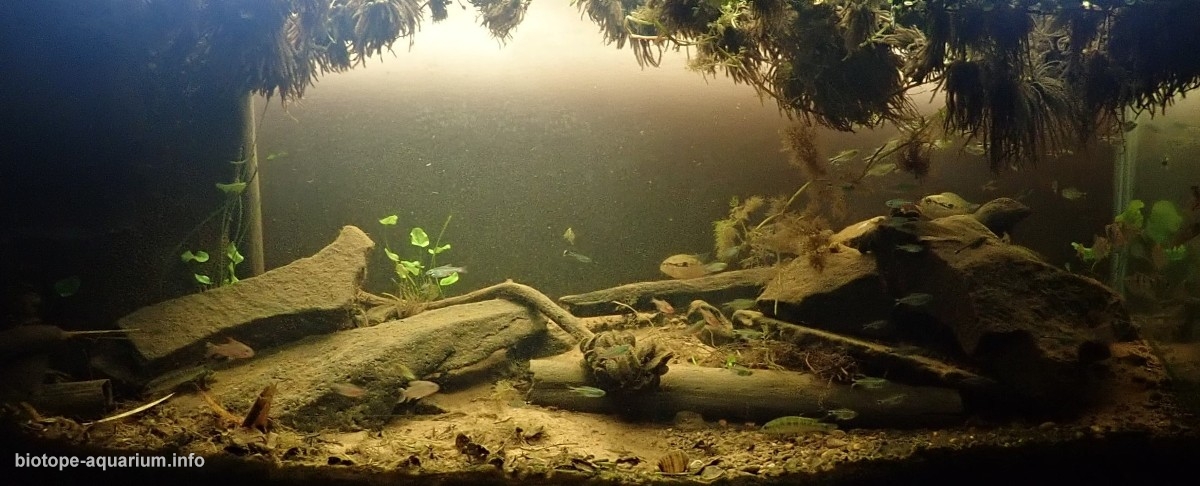Wetland of the Pindapoy Creek near the Paraná River, Misiones, Argentina
67th place in Biotope Aquarium Design Contest 2019
Argentina. Philip Cortesi

Volume: 240 L
Dimensions: 120х40х50 cm
List of fishes: Crenicichla taikyra, Bujurquina vittata, Apistogramma commbrae, Hyphessobrycon eques, Aphyocharax anisitsi, Moenkhausia bonita, Hyphessobrycon elachys, Gymnocorymbus ternetzi, Corydoras hastatus, Corydoras polystictus, Characidium zebra, Limnoperna fortunei (introduced by human), Macrobrachium sp., Pomacea canaliculata,
List of plants: Utricularia folios, Salvinia Biloba, Nymphoides indica
Description of decorations: Sandy bottom with small and middle sized rocks, some driftwood including dead branches of bambú collected from the biotope location.
Description of equipment: Internal HMF with 1500l/h pum, 2 x 100W heater, 2 x T5 light tubes (36W)
Water parameters: Temperature = 23°, PH 7.0, KH 2.00, dGH 4.00
Additional info: No water change in winter (only refill), in summer 30% weekly waterchange, lightening is from 8AM to 8PM.
INFORMATION ABOUT BIOTOPE
Description of the area surrounding the biotope: The Paraná River is with its 4800 km of length one the most important fluvial in South America. Together with the Rio Iguazú and the Rio Paraguay they form a huge and unique water system. Among the Province of Misiones, the river runs from the north to the south and is the natural border to Paraguay. Hundreds of clear water creeks like the Pindapoy enter into the river and where the landscape is plane, natural wetlands and lagoons are created. One of these wetlands is the biotope described.
The water is clear, the amount of small and middle sized fish is high. Some areas are up to 2 meters deep. Since the construction of several dams (Yacyretá, Itaipú to mention two) some areas are considered as “flooded” and you can see dead branches and trees of old forest inside the water. The bottom composition is varied from sand, reddish mud, small rocks and huge rocks. At some areas the water level does not reach more than 40 cm. The are is surrouded by native subtropical forest, planted pine-trees and natural grassland with bushes.
Description of the underwater landscape of the biotope: The undwater landscape is a composition of sandy bottom with small and middle sized rocks where some fish can live, hide and spawn. There is a lot of dead wood and some driftwood. The deepness varies from 20 cm to 2 meters. Most of the water level is exposed to the sun light and allows plants and algeas to grow. Flooded forest (since the construciton of dams) creates a special underwater scape with huge sources of food for invertebrades and insects. They, on the other side, are a infinite source of food for small and middle sized fish.
Description of the parameters of the habitat: The water is mostly transparent. After rain it can be some days turbish but the river takes all with it and the millions of molluscs are a permanent “filter”. The temperature depends on the season but the average should be around 22°. PH 7.2, dGH and KH are very low (not reching 5.00).
List of fishes and invertebrates occurring in the nature biotope: Crenicichla lepidota, Crenicichla vittata, Crenicichla taikyra, Crenicichla semifasciata, Cichlasoma dimerus, Bujurquina vittata, Gymnogeophagus balzanii, Geophagus sveni (introduced), Apistogramma commbrae, Corydoras hastatus, Corydoras polystictus, Hypostomus ternetzi, Loricaria sp., Microglanis carlae, Steindachnerina brevipinna, Apareiodon affinis, Characidium zebra, Pygocentrus nattereri, Serrasalmus maculatus, Hyphessobrycon anisitsi, Hyphessobrycon eques, Hyphessobrycon meridionalis, Psellogrammus kennedyi, Tetragonopterus argenteus, Hyphessobrycon elachys, Acestrorhynchus pantaneiro, Charax stenopterus, Pyrrhulina australis, Palaemonetes argentinus, Uncancylus sp, Chilina fluviatilis, Erodona mactroides, Zilchiopsis collastinensis, Trichodactylus borellianus, Limnoperma fortune (invasive)
List of plants found in the nature biotope: Pistia stratiotes, Eichhornia crassipes, Nymphoides indica, Salvinia biloba, Utricularia folios
Threats to the ecology: As mentioned, important ecological aspects are the construction of hydroelectrical dams. They changed the entire system and destroyed important paths of migrating fish like Dorado (Salminus brasiliensis), Surubí (Pseudoplatystoma corruscans) or Pacú (Piaractus mesopotamicus). Together with the impact of the global and regional climate change and the huge amount of human-produced waste, the entire system is pushed to its limits of survival. Unfortunately, the impact is irreversible.
Sources of information:
Guia de los peces del Parque Nacional Pre-Delta
http://naturalis.fcnym.unlp.
http://www.pecescriollos.de/
http://www.pecescriollos.de/
http://www.pecescriollos.de/
www.pecescriollos.com.ar
Catalogue of the specimens of Trichodactylidae(Crustacea, Brachyura) housed in the Museo de La Plata, Argentina https://www.fcnym.unlp.edu.ar/
El problema del mejillón dorado: eso que los barcos llevan y traen
https://www.conicet.gov.ar/el-
http://www.inbiar.uns.edu.ar/
http://ve.scielo.org/scielo.
https://www.researchgate.net/
http://www.unl.edu.ar/
http://www.ecoregistros.org/
